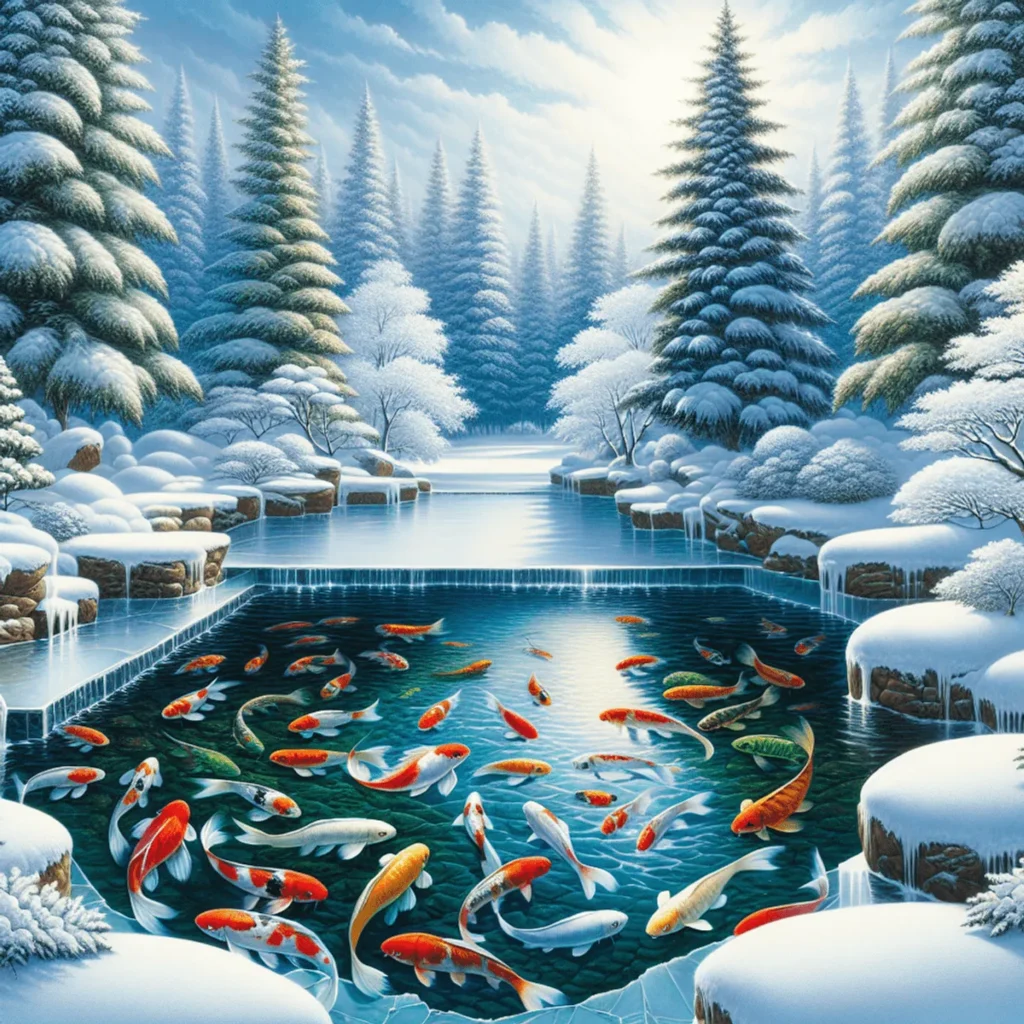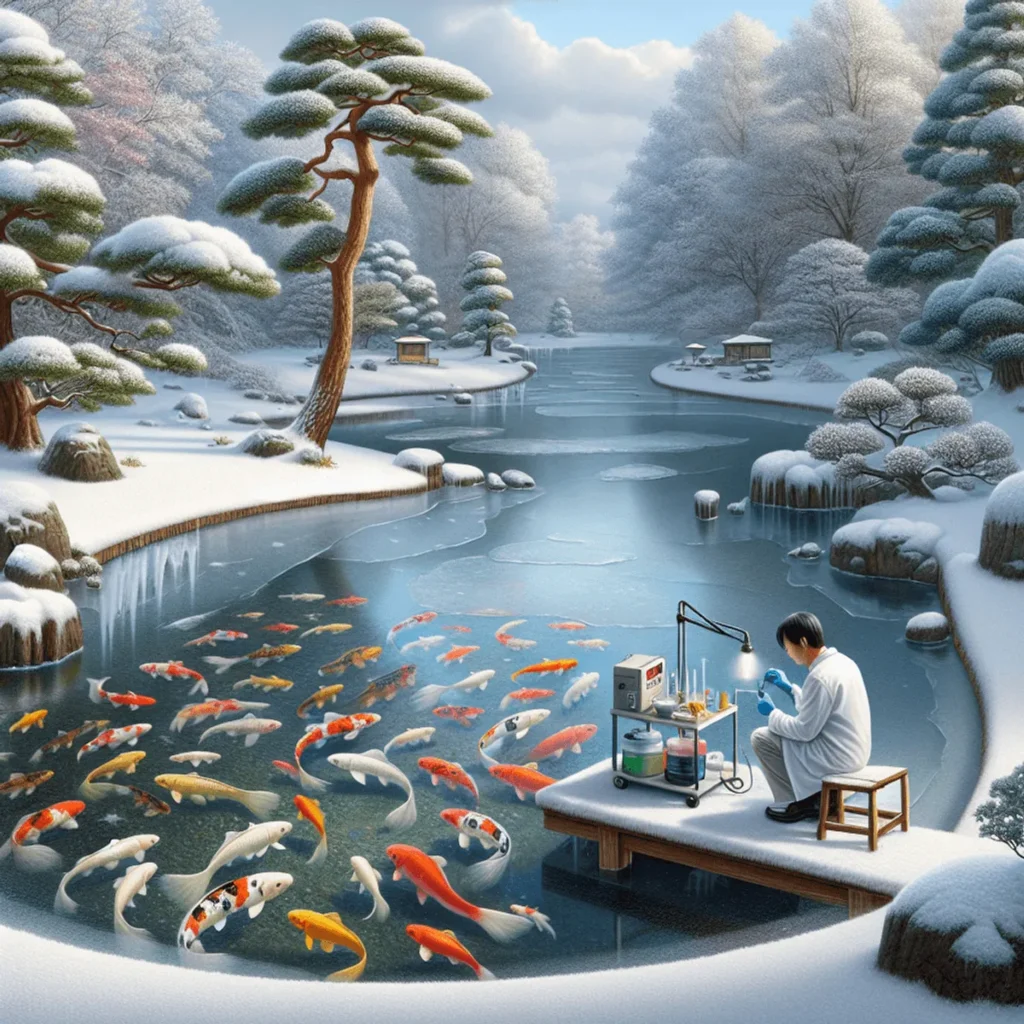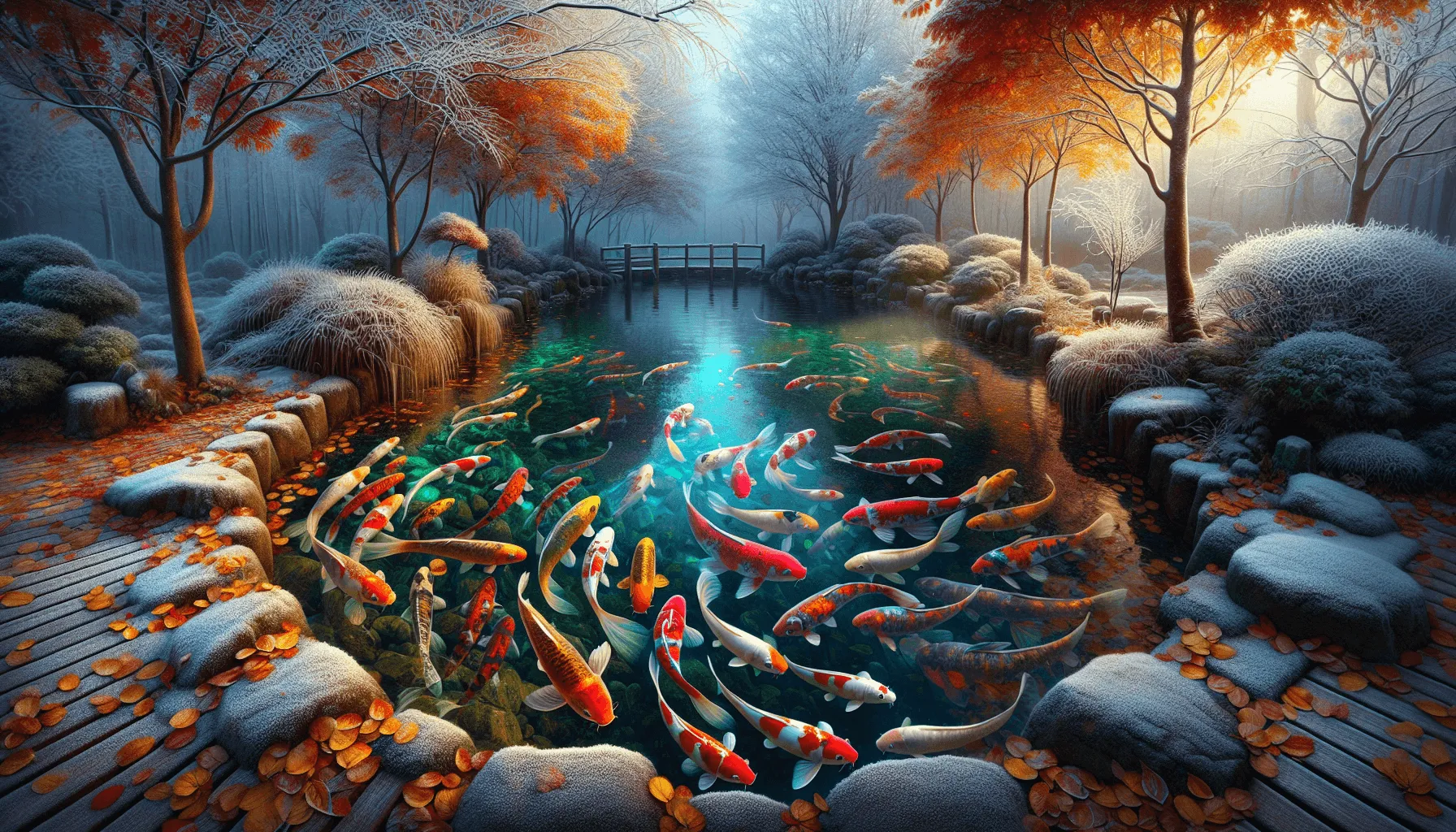Koi fish, known for their vibrant colors and graceful swimming, are a popular choice for outdoor ponds. These ornamental carp thrive in various environments, often adapting to the specific conditions of their habitat. However, as winter approaches, concerns arise regarding their ability to endure the cold.
Understanding how koi fish survive winter in outdoor ponds is essential. These cold-blooded creatures enter a state of dormancy when temperatures drop, significantly slowing their metabolism. This adaptation allows them to withstand harsher conditions than many might expect.
Key takeaway: With the right preparation and care, koi fish can thrive even in the coldest months. By ensuring proper pond maintenance and monitoring water quality, you can help your koi navigate winter successfully.
Understanding Koi Fish Biology and Behavior During Winter
Cold-Blooded Animals and Survival in Cold Water
Koi fish are cold-blooded animals, meaning their body temperature fluctuates with the surrounding environment. This characteristic significantly impacts their ability to survive in cold water. As water temperatures drop, koi fish undergo physiological changes that allow them to adapt to the colder conditions.
Metabolism and Dormancy
When temperatures fall, the metabolism of koi fish slows down considerably. This reduction in metabolic rate leads koi into a state of dormancy or hibernation. During this period, their activity levels decrease, and they conserve energy by staying mostly immobile at the bottom of the pond where the temperature is more stable. These biological adaptations are essential for their survival during winter.
Key Takeaway
By understanding these natural behaviors and physiological changes, you can better prepare your outdoor pond to support koi survival during the coldest months.
Essential Conditions for Koi Survival in Outdoor Ponds During Winter Months

Maintaining suitable water conditions is crucial for ensuring the health and well-being of koi fish during winter. Key aspects include water temperature, pond depth, and oxygen levels.
Water Temperature Requirements for Koi Survival
Koi fish can survive in cold water, but there are specific temperature thresholds to keep in mind:
- Ideal Range: Keep water temperatures above 40°F during winter months to prevent health issues. Temperatures below 40°F can lead to stress and increased susceptibility to diseases.
- Thermometer Use: Regular monitoring with a pond thermometer ensures you maintain this ideal range.
Pond Depth Considerations for Winter
The depth of your pond plays a significant role in koi survival during winter. It’s important to understand why pond depth matters:
- 3-5 Feet Depth: A pond depth of at least 3-5 feet helps prevent the entire pond from freezing solid. This depth provides access to liquid water where koi can stay during their dormant phase.
- Stable Temperature Zones: Deeper ponds offer more stable temperature zones, reducing the risk of rapid temperature fluctuations that can stress your koi.
Ensuring Adequate Oxygen Levels and Water Quality Maintenance in Winter Ponds
Oxygen levels are vital for koi health, even as temperatures drop:
Importance of Maintaining Oxygen Levels
- Oxygen Needs: Koi require adequate oxygen levels to survive, even during their dormant phase. Insufficient oxygen can lead to respiratory distress and other health problems.
- Winter Challenges: Cold water holds less dissolved oxygen, making it essential to take measures that ensure proper oxygenation.
Role of Aerators and De-Icers
Using aerators and de-icers are valuable tools for maintaining oxygen levels and preventing ice formation. Here’s a winter pond aeration guide you might find helpful:
- Aerators:Promote gas exchange by circulating water.
- Prevent the formation of a complete ice cover, which can trap harmful gases beneath the surface.
- De-Icers:Keep a small area of the pond ice-free.
- Allow toxic gases to escape while letting fresh oxygen enter the water.
These devices ensure your koi have access to the oxygen they need, even when temperatures plummet.
In addition, winterizing your koi pond is crucial for maintaining optimal conditions. This includes adjusting the water temperature, ensuring appropriate pond depth, and implementing strategies for adequate oxygenation.
Maintaining suitable water conditions—including temperature, depth, and oxygen levels—ensures your koi fish remain healthy throughout the winter months. Also remember that while koi can endure colder temperatures than most fish species, certain conditions must be met for their survival.
Preparing Your Koi Pond for Winter: A Step-by-Step Guide
Getting your koi pond ready for winter is essential to keep your fish healthy and safe during the colder months. To make sure everything is set before the first frost, follow these steps:
Cleaning and Preparing the Pond
1. Remove Debris and Organic Matter
Fallen leaves, twigs, and other organic debris can degrade water quality by producing harmful substances like ammonia as they decompose.
- Use a skimmer net to clear the pond surface.
- Use a pond vacuum for deeper cleaning.
2. Check and Clean Filters
Ensure that mechanical and biological filters are clean and functioning optimally to maintain water quality.
- Replace any worn-out filter media to ensure efficient filtration throughout winter.
3. Trim Aquatic Plants
Cut back dead or dying plant material to prevent decay in the water.
- Remove tropical plants or move them indoors if necessary.
4. Inspect Pond Equipment
Test aerators, pumps, and de-icers to ensure they are operating correctly.
- Consider having backup equipment on hand in case of failures during extreme weather conditions.
Feeding Practices Before and During Winter for Koi Fish Health
Adjusting your koi fish’s diet is crucial as temperatures drop. Here’s how you can do it:
- Switch to a Winter Diet: As water temperatures fall below 60°F, transition to wheat germ-based food which is easier for koi to digest in cold water.
- Monitor Water Temperature: Use a reliable pond thermometer to track temperature changes.
- Stop Feeding at the Right Time: Koi fish enter a state of dormancy when water temperatures fall below 40°F, during which they do not require food.
Key Takeaway
Taking proactive steps in cleaning, maintenance, and adjusting their diet are key elements of getting your koi pond ready for winter. By doing so, you create an environment where your koi can safely endure the harsh conditions of winter.
Special Considerations for Severe Winters: Protecting Your Koi Fish from Extreme Cold
Techniques for Insulating Above-Ground Ponds During Harsh Winters
In regions where temperatures drop significantly, insulating above-ground ponds can provide essential protection for your koi fish. Here are some effective techniques for insulation:
- Using pond covers: Heavy-duty pond covers or tarps can help retain heat and prevent the water from freezing. These covers also shield the pond from snow and debris.
- Applying insulating materials: Surrounding the pond with insulating materials like straw bales, foam boards, or bubble wrap can reduce heat loss. These materials act as barriers to cold winds and help maintain a more stable water temperature.
- Installing windbreaks: Erecting windbreaks around the pond area with fences or shrubbery can minimize the chilling effect of winter winds on the water surface.
By implementing these methods, you increase the chances that your koi will survive harsh winter conditions by maintaining a more stable and warmer environment.
Indoor Care Options for Koi Fish During Harsh Winters
When outdoor conditions become too severe, moving your koi fish indoors might be necessary. Here’s how to approach an indoor tank setup for koi:
Determine when to move koi indoors:
- If temperatures consistently drop below freezing and ice formation is unavoidable despite insulation efforts.
- When oxygen levels cannot be adequately maintained outdoors due to extreme cold.
Setting up an indoor tank:
- Choose a large enough tank to accommodate your koi comfortably, considering their size and numbers.
- Install a reliable filtration system to maintain water quality.
- Ensure proper aeration with air pumps to keep oxygen levels stable.
- Maintain a stable temperature using aquarium heaters if necessary. Aim for temperatures between 50°F and 60°F.
Maintaining an indoor environment suitable for koi:
- Regularly monitor water quality parameters such as pH, ammonia, and nitrate levels.
- Perform routine water changes to keep the environment clean.
- Provide a balanced diet appropriate for indoor conditions, possibly continuing with wheat germ-based food if temperatures are still cool.
These steps ensure that even in the most extreme winter conditions, your koi will remain healthy and safe until they can return to their outdoor habitat.
By effectively insulating above-ground ponds or moving koi indoors during harsh winters, you take proactive measures to protect them from extreme cold. This dual approach ensures that regardless of weather severity, your koi fish have the best chance of survival during winter months.
Monitoring Water Quality Throughout Winter: Ensuring Healthy Conditions for Your Koi Fish

Regular water quality testing during winter months is essential to ensure healthy conditions for your koi fish. Key parameters to monitor include:
- Ammonia Levels: High ammonia levels can be toxic to koi. Regular testing helps prevent harmful buildups.
- pH Balance: Maintaining a stable pH level between 7.0 and 8.5 is crucial for koi health.
Maintaining Beneficial Bacteria Levels in Cold Water Environments with UV Lights or Other Methods
Beneficial bacteria play a significant role in maintaining balanced water quality during winter. These microorganisms help break down waste products, reducing ammonia and nitrite levels. However, when temperatures drop too low, some beneficial bacteria strains may struggle to thrive naturally.
Consider these methods for maintaining beneficial bacteria levels:
- UV Lights: While primarily used for controlling algae, UV lights can support a healthy bacterial balance by preventing harmful pathogens from proliferating.
- Cold-Water Bacterial Supplements: Specialized supplements designed for cold-water environments can boost beneficial bacteria populations.
Can koi fish survive winter? Yes, with the right care, including diligent water quality management, they can thrive even in the coldest months. Regularly monitoring and adjusting water conditions will help keep your pond environment safe and stable throughout winter.
Conclusion: Ensuring the Long-Term Survival of Your Koi Fish Through Proper Winter Care Strategies
Maintaining the health and well-being of your koi fish requires a year-round commitment. Cold temperatures pose significant challenges, but with the right preparation and care, can koi fish survive winter? Absolutely.
- As a responsible owner, consistently addressing seasonal challenges ensures your koi remain safe, even during extreme cold.
- Implementing the discussed strategies will allow you to enjoy watching your beloved pets swim gracefully amidst wintry landscapes.
Taking proactive steps will safeguard your koi fish against the harshest winter conditions.
FAQs (Frequently Asked Questions)
Can koi fish survive winter in outdoor ponds?
Yes, koi fish can survive winter in outdoor ponds with the right preparation and care. It’s essential to maintain suitable water conditions and ensure that the pond does not freeze completely.
What temperature range is necessary for koi fish survival during winter?
Koi fish thrive best when water temperatures are kept above 40°F during winter months. Maintaining this temperature is crucial for their health and well-being.
How do koi fish adapt to cold water during winter?
Koi fish are cold-blooded animals, which means their metabolism slows down as temperatures drop. This leads them to enter a state of dormancy or hibernation, allowing them to conserve energy until warmer weather returns.
What steps should I take to prepare my koi pond for winter?
To prepare your koi pond for winter, clean and remove debris, check water quality, ensure adequate oxygen levels with aerators or de-icers, and transition to a suitable winter diet for your koi.
How can I maintain oxygen levels in my koi pond during winter?
Maintaining oxygen levels is vital for koi health even in colder temperatures. Using aerators and de-icers can promote oxygen exchange and prevent ice formation on the surface of the pond.
What should I do if winters become extremely harsh for my koi fish?
In extremely harsh winters, consider insulating above-ground ponds for extra protection or moving your koi indoors if outdoor conditions become too severe. Ensure that indoor environments meet their needs for temperature and water quality.




